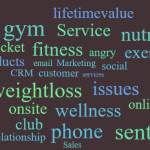Prochaska’s stages of change model helps wellness professionals understand why people “just won’t change.” Here’s an overview.
Do you know people who fit each of these stages?
Pre-contemplation
These folks aren’t even THINKING about making a lifestyle change.
Lowering their blood pressure, losing weight, eating better, getting more active — none of that’s on their radar.
They don’t even register that kind of information in the news. In fact, they’ll often tell you that they don’t know information that is astonishingly available — for example, that short daily walks are good for you.
Sometimes, these folks tried to make a lifestyle change in the past and feel that it resulted in abject failure — failure so spectacular that it turned them off the entire idea.
My friend is a good example of this. She was inactive but wanted to start exercising and eating better. She started working with a personal trainer who pushed her too hard, too fast. She was in agony from DOMS — and within three sessions injured her back because she was trying to lift weights that greatly exceeded her current ability.
Those bad experiences thoroughly squashed her tentative confidence and she gave up entirely. It took nearly ten years before she was willing to try again — and at that point, she had gained an additional 50 pounds.
Don’t bother marketing to these folks. Public health communications about the dangers of obesity, high blood pressure, inactivity and other health-endangering lifestyle habts are targeted at this audience.
Some of these folks will eventually develop an interest in making lifestyle changes, but their timeline is much too long and uncertain for businesses to target.
Contemplation
Folks contemplating change are, well…thinking about it! They’re weighing the tradeoffs of making a lifestyle change.
For example, they kick around the idea of walking with a neighbor in the mornings – but are discouraged by the thought of getting up even earlier, needing to get a shower, not having time to swing through the drive-through for coffee on the way to the office.
Marketing to these folks should focus on countering objections — identifying ways around obstacles to change.
It’s also a good time to shatter myths and misconceptions that may be scaring people off. For example, they may mistakenly think that the only exercise that counts is jogging.
Preparation
The thinking of people who are preparing for a lifestyle change shifts from seeing problems to seeing possibilities.
They compare options with a view to finding what will work best.
For example, someone in the preparation stage may have made a tentative decision to join a health club. Now the question may be which one: a full-service commercial club, a full-service not-for-profit, a women-only facility, or a keycard-access 24-hour club.
These folks have also begun making tiny changes. Taken alone, these small changes won’t add up to significant health improvement. They’re important for a different reason: they signal a feeling of self-efficacy – the belief that you can count on yourself to follow through.
For example, they may be adding a packet of Splenda instead of a packet of sugar to their morning coffee, or switch to skim from 2% or full-fat milk. Or they may order the apple slices instead of the fries at McDonald’s.
Target these people with confidence-building marketing. Encourage their small steps and reduce the risk of taking bigger steps. For example, offer a money-back guarantee.
Action
People in the Action stage make significant and ongoing lifestyle changes or enhancements. Your members, clients, patients, customers and students are all people in the Action phase.
For example, they may start walking 10 minutes every other day. In a month, they’ve upped it to 20 minutes every other day. And in two months, they’ve increased the frequency to every day Monday through Friday.
In this phase, it’s important to keep pace with your customer! Celebrate their successes and focus on helping them feel part of a community of people with shared goals and successes.
Make sure that that your customers can continue to experience personal growth — but calibrate those challenges and opportunities to your customers.
For example, not everyone wants to challenge themselves by pushing harder and faster. Sometimes it’s about trying something new. Or sharing what you’ve learned and experienced with someone else.
Maintenance and relapse
Think of this as the “keep on keeping on” stage. Folks who are maintaining lifestyle habits continue to take those actions and even enhance them. For example, someone who’s already eating at least 7 servings of fruit and veggies a day may decide to drop processed juice in the morning and squeeze it fresh instead.
Someone who’s already very active may decide to amp up her exercise routine — adding a longer run, or starting martial arts lessons.
However, the norm is that some habits slip over time back towards less healthy behaviors: “relapse.”
At Radial we hate the term “maintenance and relapse.” We like to call this phase “recommitment” or “tweaking and tuning”.
Relapse sounds like failure. The truth is that our lives change constantly.
It’s not that we wimped out on being healthy. In reality, we got a huge new project at work…an elderly parent suddenly got sick…or the kids’ summer schedule is crazy.
So it should come as neither a surprise nor a disappointment that we need to tweak and tune how we stay active, feed ourselves, and maintain physical, mental and emotional reserves.
In this phase, focus on helping customers solve problems that may derail them.
For example, if you know you’ve got a lot of soccer moms, think about products and services that help them stay active while kids are at practice, instead of just sitting in the car waiting.
Something as seemingly unrelated to healthy living as a time management class may help members find ways to eat at home more or stick to a workout schedule.
(Jim Prochaska’s consumer-oriented book “Changing For Good” is an excellent introduction if you’d like to know more about the science.)




